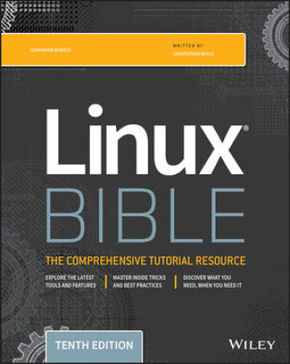| Verlag | Wiley & Sons |
| Auflage | 2020 |
| Seiten | 928 |
| Format | 18,9 x 23,7 x 4,9 cm |
| Gewicht | 1672 g |
| Artikeltyp | Englisches Buch |
| Reihe | Bible |
| EAN | 9781119578888 |
| Bestell-Nr | 11957888UA |
The industry favorite Linux guide
Linux Bible, 10th Edition is the ultimate hands-on Linux user guide, whether you're a true beginner or a more advanced user navigating recent changes. this updated tenth edition covers the latest versions of Red Hat Enterprise Linux (RHEL 8), Fedora 30, and Ubuntu 18.04 LTS. It includes information on cloud computing, with new guidance on containerization, Ansible automation, and Kubernetes and OpenShift. With a focus on RHEL 8, this new edition teaches techniques for managing storage, users, and security, while emphasizing simplified administrative techniques with Cockpit. Written by a Red Hat expert, this book provides the clear explanations and step-by-step instructions that demystify Linux and bring the new features seamlessly into your workflow.
This useful guide assumes a base of little or no Linux knowledge, and takes you step by step through what you need to know to get the job done.
_ Get Linux up and running quickly
_ Master basic operations and tackle more advanced tasks
_ Get up to date on the recent changes to Linux server system management
_ Bring Linux to the cloud using Openstack and Cloudforms
_ Simplified Linux administration through the Cockpit Web Interface
_ Automated Linux Deployment with Ansible
_ Learn to navigate Linux with Amazon (AWS), Google (GCE), and Microsofr Azure Cloud services
Linux Bible, 10th Edition is the one resource you need, and provides the hands-on training that gets you on track in a flash.
Inhaltsverzeichnis:
Acknowledgments xi
Introduction xxxv
Part I: Getting Started 1
Chapter 1: Starting with Linux 3
Chapter 2: Creating the Perfect Linux Desktop 27
Part II: Becoming a Linux Power User 59
Chapter 3: Using the Shell 61
Chapter 4: Moving Around the Filesystem 93
Chapter 5: Working with Text Files 113
Chapter 6: Managing Running Processes 131
Chapter 7: Writing Simple Shell Scripts 147
Part III: Becoming a Linux System Administrator 165
Chapter 8: Learning System Administration 167
Chapter 9: Installing Linux 195
Chapter 10: Getting and Managing Software 221
Chapter 11: Managing User Accounts 249
Chapter 12: Managing Disks and Filesystems 273
Part IV: Becoming a Linux Server Administrator 305
Chapter 13: Understanding Server Administration 307
Chapter 14: Administering Networking 339
Chapter 15: Starting and Stopping Services 369
Chapter 16: Configuring a Print Server 403
Chapter 17: Configuring a Web Server 427
Chapter 18: Configuring an FTP Server 455
Chapter 19: Configuring a Windows File Sharing (Samba) Server 475
Chapter 20: Configuring an NFS File Server 499
Chapter 21: Troubleshooting Linux 523
Part V: Learning Linux Security Techniques 563
Chapter 22: Understanding Basic Linux Security 565
Chapter 23: Understanding Advanced Linux Security 599
Chapter 24: Enhancing Linux Security with SELinux 635
Chapter 25: Securing Linux on a Network 663
Part VI: Engaging with Cloud Computing 691
Chapter 26: Shifting to Clouds and Containers 693
Chapter 27: Using Linux for Cloud Computing 709
Chapter 28: Deploying Linux to the Cloud 729
Chapter 29: Automating Apps and Infrastructure with Ansible 749
Chapter 30: Deploying Applications as Containers with Kubernetes 765
Part VII: Appendixes 785
Appendix A: Media 787
Appendix B: Exercise Answers 797
Index 863

